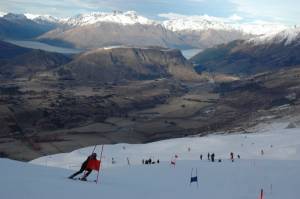Queenstown, New Zealand – The women’s U.S. Alpine Ski Team, including Olympic gold medalists Lindsey Vonn and Julia Mancuso, will begin their first on-snow camp since May this week at Coronet Peak ski area in New Zealand.
The annual multi-week summer session is heavily focused on technique with gate training almost exclusively locked on giant slalom for speed skiers, while technical skiers will also work on slalom. Both groups will test numerous ski, boot and binding set-ups throughout the camp.

“This is primarily a giant slalom camp focused on technique, but we’ll also do a good bit of freeskiing on super G skis and a ton of equipment testing,” explains Alex Hoedlmoser, U.S. Ski Team women’s Head Coach. “The open hill scenario also allows us to create a number of testing scenarios in order for the athletes to find out what equipment responds the best on different snow conditions.”
Also in attendance at the camp are World Cup podium finisher Mikaela Shiffrin and the remainder of the downhill team, including Stacey Cook, Leanne Smith, Laurenne Ross and Alice McKennis.
“This camp is a great opportunity for all of us to get back on snow comfortably and really dial in our technique and equipment before we start training speed in Chile,” said Smith, of North Conway, N.H. “If you have good technique in giant slalom, then you’ll have good technique in downhill and super G, too.”
The landscape of Coronet Peak allows U.S. coaches to train athletes on up to five different slopes each injected with water to varying degrees in order to mimic a multitude of different Audi FIS Alpine World Cup race conditions.
“Coronet Peak is the perfect location for our athletes to return to on-snow training. There are five different training slopes, so we’re able to set a variety of course sets and it also allows us to inject each surface with different levels of ice,” said Hoedlmoser. “Essentially, we can create a lot of different World Cup conditions. It’s a lot of work for our staff, but it’s extremely productive for our athletes.”
“The terrain at Coronet Peak is awesome and perfect for what we need to accomplish,” added McKennis, of Glenwood Springs, Colo. “We train on a T-bar, so you can get 30 runs in a day if you want to get after it. Our coaches always do a great job of preparing the snow surface, which gives us a lot of opportunity to get things dialed.”

